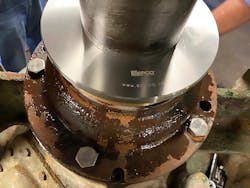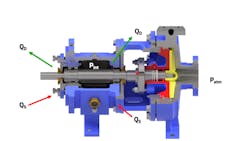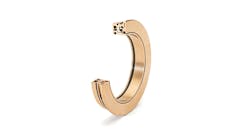If you do a Google search for “bearing failure,” the search engine will show 296 million results. However, a search for “bearing reliability” only gives 77 million results. So, there is a lot more online regarding bearing failure than there is about bearing reliability.
Many factors may affect bearing reliability. Bearing issues or failure also causes many system failures in processing plants. Some factors that affect bearing life include:
- Design
- Quality
- Storage and handling
- Installation and proper alignment
- Lubrication
A study by SKF showed that most bearing failures (63%) were caused by contamination in the bearing housing. This includes 52% that were caused by contaminants (water and particles) mixing with the lubricant.
If you filter your new oil and ensure clean oil is in your equipment, how does it get contaminated and why should plant teams care?
Why is bearing protection important?
Bearing failure can cost industries billions of dollars every year. With replacement parts, ancillary equipment failures, downtime, wasted product and labor hours, these costs may often be higher than calculated by plant teams.
A 2015 MIT bearing study estimated that poorly lubricated equipment can cost industries in the U.S. about $240 billion. This estimate gives plant teams about 240 billion reasons to care about protecting their bearings and ensuring the delivery of clean lubricant to those bearings.
What are the sources of lubricant contamination?
These steps (Figure 1) are the path to lubrication reliability:
- Right type of lubricant — select the ideal lubricant for the asset
- The right quality of storage and handling
- The right amount
- The right place — the correct lubricant in the intended asset
- The right time — when should the lubricant be replaced
If teams follow all these steps, the lubricant may operate reliably for years. So, why do most plants and facilities encounter problems? Somewhere along the way, something goes wrong. It is often within the bearing housing itself.
Lip seals — that are initially installed as oil seals — wear out and allow contaminants into the lubricant. Breathers can allow dust or water vapor in. Some filters, if not changed or cleaned properly, become dirty and ineffective.
Dust and vapor/water that enter the bearing housing are tiny (Figure 2). These particles are the problem because they are small enough to enter the space between the bearings and the race. Roller bearing clearances are between 1 µm and 4 µm, so only particles this size and smaller are of huge concern. Once contaminants enter the lubricant, more problems arise.
What problems can contamination cause?
Particles in the lubricant, especially invisible contaminants, enter the races of the bearings and cause damage. This damage alone may cause bearing issues and ultimately failure.
However, this is only part of the problem. The damage caused by the fragments results in more particles called wear particles, and those cause more wear particles. It becomes a cycle of damage. In most instances, replacing the lubricant is the only way to correct the problem.
When wear occurs, the patterns on the bearings and the races may indicate system problems. So, before replacing the lubricant and restarting, examine the patterns to help solve system issues that will only cause the bearings to fail again.
What are the wear modes?
Don’t waste a failed bearing. Take a look, or partner with a tribology or reliability expert, to examine the bearings’ wear patterns and particles in the lubricant. This examination will help determine if system upsets or other problems caused or added to the bearing damage, which may not always begin because of contamination.
Particles and patterns on bearings can indicate many problems. These include:
- Misalignment
- Faulty mounting practice
- Incorrect shaft and housing fits
- Inadequate lubrication
- Ineffective sealing
- Vibration
- Passage of electric current through the bearing
- Improper transportation, storage, and handling
While this article focuses on lubrication, other system problems can be identified by examining the damaged bearings. Any damage will create wear particles that will enter the lubricant. Ultimately, a clean lubrication system will help minimize bearing damage.
How does the ideal bearing protection help?
If lip seals and other contacting oil seals have faults or wear and allow contamination to enter the lubricant, what is the answer? Often, a noncontacting bearing isolator, particularly one that expels contaminants and seals when equipment is off, is often a good solution.
Compound labyrinth bearing isolators are designed to keep contaminants out, including during shutdown. If any contaminants enter the isolator, the design uses clearances, gap changes and direction changes to control them. The technology expels contaminants using centrifugal force and gravity. The contaminants exit the seal away from the bearing. This prevents lubricant contamination and extends lubricant and bearing life.
During shutdown, traditional bearing isolators may allow contaminants to enter as the bearing housing reaches equilibrium (Figure 3). During operation, atmospheric pressure (Patm) is greater than the internal pressure (Pint) of the bearing housing. Because of this, the natural flow is out of the bearing housing. When equipment is shutdown, Patm is greater than or equal to the Pint, so the natural flow reverses. In this situation, until equilibrium is reached, dust, vapor and other contaminants may enter the bearing housing.
To avoid this, some isolator designs include condensate/mist-coalescing rings, which provide a throttling gap (Figure 4). As the airborne contaminants and vapor are drawn through the seal, the energy is broken down because it is forced through this axial throttling gap. It then continues through the longer radial gap where the contaminants’ energy is broken down further. There, it is captured within the internal condensate trap and allowed to drain out through a small static weep hole (the condensate drain) at the six o’clock position of the bearing isolator.
In addition to preventing contamination, these bearing isolators keep lubricant within the bearing cavity, where it belongs. As a result, the lubricant performs its purpose, keeping the bearing components apart and preventing premature failure. Less contact of bearing components means less wear, which means extended bearing life. Also, this type compound labyrinth seal should never need replacement, providing even greater cost savings.
By increasing the bearing’s life, the electric motor’s life can easily be extended. In many cases, this extended life can be doubled or greater.
Chris Tindell, CMRP, is a regional business manager for Sealing Equipment Products Co. Inc. (SEPCO). He is a maintenance and reliability professional with more than 20 years of experience in reliability consulting, training and troubleshooting equipment. He is an experienced vibration and lubrication analyst and maintains professional certifications in multiple engineering technology fields. Tindell has worked in many manufacturing industries auditing and optimizing PSM maintenance programs and providing training on RCM and Lean manufacturing strategies. Tindell may be reached at [email protected].
SEPCO






